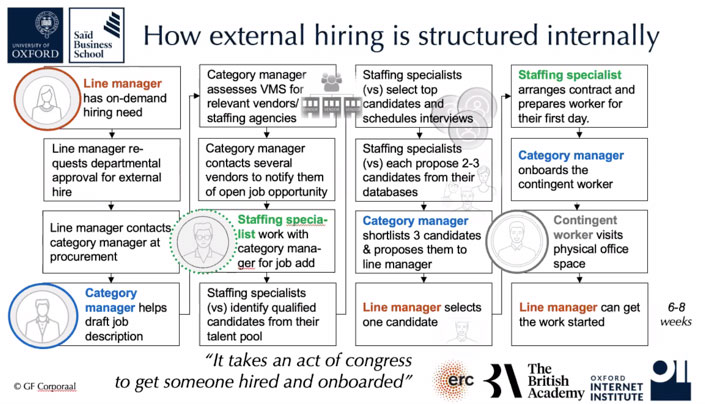HRTech
Strategy in nascent markets: Utmost and the extended workforce.
My regular merry band of readers may remember I’m spending time studying strategy. I figured as I run a strategy advisory, it would make sense to develop a good understanding of the latest academic research into strategy. Hence I’m at Oxford doing the Post Grad Diploma in Strategy and Innovation. I say at Oxford, but Covid has meant we get to hang out in Zoom, with virtual spires. I wrote about applying some of what I learnt in the first module here. As improve my knowledge of the theory, I aim to apply it thoughtfully to my clients. Hopefully without over complicating things.

Whose market is it anyway?
One of the problems of neo-classical economics is the assumption that markets exist. Quite a lot of business school theory takes the industry or market as a given. The second module challenged that assumption. Markets are created, initially by entrepreneurs. Markets are dynamic and can be very messy. Market creation is a significant field of research, so Marc Ventresca and Victor Seidel took us through several models and case studies. As we went this there were many moments that resonated with my career experiences and more recent work I have been doing with clients. See tweet thread for more about my reminiscence.
Digital labour markets
One session included an excellent presentation on digital labour markets by Dr Greetje Corporaal. Her work on gig platforms is fascinating, and links so closely the world of HRTECH. Check out this report.
One section of her research project looked at the frictions and challenges that large enterprises face in actually hiring external labour. She interviewed several F500 company managers in the project. I thought this slide was spot on.
 f
f
This precisely the challenge that one of my clients, Utmost, is aiming to address.
This morning on my walk I was thinking about one of the papers we read. So instead of spending my morning doing email, thought I would pick up part of that paper and apply it to Utmost. See website and blog here.
Some Strategy theory: Nascent markets.
Constructing Markets and Shaping Boundaries: Entrepreneurial Power in Nascent Fields
https://doi.org/10.5465/amj.2009.43669892. (or search and you will find).
One of the papers we looked at was Santos and Einsenhardt’s Constructing Markets and Shaping Boundaries: Entrepreneurial Power in Nascent Fields . The paper is from a heavyweight academic journal, rather than the more accessible Harvard Business Review fare, but it is worth grinding through. It took me a few attempts.
It looks at how entrepreneurs create new markets (Please excuse the rampant cutting and pasting, but I thought you could do a bit of dense academic writing with your coffee).
Entrepreneurs in nascent markets face an ambiguous environment with unclear customers, undefined product attributes, and no well-established industry value chain. Our data suggest that, in light of this ambiguity, entrepreneurs in nascent markets often devote significant effort to claiming the market—that is, defining a distinct identity for both the firm and market so that the two become synonymous. If entrepreneurs are successful, their firm becomes the cognitive referent for the claimed market: the organization that relevant others (e.g., customers, partners, analysts, and employees) automatically recognize as epitomizing the nascent market.“
The authors define three stages:
(1) claim a new and distinct market space and become its “cognitive referent” through identity-based actions;
(2) demarcate this market by specifying firm and market boundaries through alliances with established firms;
(3) control the market by overlapping the boundaries of the firm and market over time through acquisitions that eliminate entrepreneurial rivals.
Within the claim stage:
Our data indicate that entrepreneurs use three identity mechanisms to claim a market:
(1) “Adopt templates” is defined as using well-known cognitive models from other domains (either in isolation or combination) to convey a unique identity. This identity simultaneously makes a firm and its nascent market distinct, yet also familiar and understandable to market audiences.
(2) “Disseminate stories” is defined as spreading symbolic narratives (real or fictitious) to raise awareness about the firm and its market, and communicate the firm’s identity.
(§)“Signal leadership” is defined as taking concrete actions that convey superior power and expertise within the market
Applying the claim stage of the theory to Utmost
- Adopt templates: Utmost has combined the now well-defined constructs of native cloud computing for the enterprise to the challenge of the workforce that isn’t an employee. What they term the “extended workforce”. This has created a market distinct from both core HR and the traditional VMS market. The message is both disruptive and familiar to its target audience, to be specific, large multinationals with complex workforces, running Workday. Utmost continues to be very deliberate and focused in defining the extended workforce concept. This positioning was not an accident, but grounded in solid research to understand the business problem, the various buying centres, existing constraints and a vision of how work will evolve. Modern cloud technology helps create what Geroski called bundles of opportunity. SaaS native cloud has become the dominant design for new enterprise software delivery.
- Disseminate stories: Utmost worked with early customers and its ecosystem to create a strong narrative for change. This began to resonate with analysts and other market watchers, and it helped link Utmost to the market it is creating. Both Utmost and Workday benefit from their close relationship. Workday’s investment and partnership is in itself part of the Utmost narrative. For Workday, the narrative is one of being more open and encouraging an ecosystem through its venture model and GTM efforts.
- Signal leadership: Now with a growing customer base, Utmost is able to build on customer success case studies to define the extended workforce as a market category. This gels well with the modern technology message too. They have also been effective in signalling what they are not. By deliberately not positioning in traditional categories, they signal new leadership.
Markets overlap, markets are leaky
New markets rarely exist in a vacuum, they overlap with existing and other nascent markets. And when new markets emerge that are adjacent or that disrupt existing markets, incumbents sometimes respond. Markets are porous, in that value flows from market to market. Incumbents and new entrants attempt to reset what the theory calls boundaries. We will see this dynamic play out with Utmost and the traditional VMS vendors, and to some extent HR vendors. This is going to be fun.
Applying models in practice
Strategy models and techniques are meant to be used in the field, and that is exactly what I plan to do. The course is giving me a new vocabulary and toolset. It will be an experiment for me, and my clients. There is more to strategy than SWOT charts and random TAM numbers. I suspect will inflict more models on my readers here too. Roger's ACCORD model might be next.
Final thoughts
While the Oxford course is both time intensive and a significant investment, so far it has been really useful. I’m hoping that the next module will be in-person. The cohort is made up of such interesting people, it would be a shame to only know them via the looking glass of Zoom.
(Disclosure: Utmost is a client, Workday is a client)



